Quince…what?
Day after day and hour after hour during the Sundance Film Festival I asked every journalist, distributor and agent I ran into what they’d seen and liked (or half-liked). I must have asked this question 60 or 70 times over the eight days I was up there…
And nobody mentioned Quinceanera, a small-scale drama about sexual tensions vs. Hispanic community values in L.A.’s Echo Park. It was like it didn’t exist…one of those strugglers that sometimes get lost in the shuffle.

I can guess but I don’t precisely know who these guys are, but they’re Quinceanera costars. Possibly Jesse Garcia and Emily Rios.
And yet Wash Westmoreland and Richard Glatzer’s film not only won the Dramatic Grand Jury Prize last night but the Dramatic Audience Award, which hasn’t occured at a Sundance Film Festival since Tony Bui’s Three Seasons took the same two prizes in 1999.
I guess I should spend more time talking to non-pro types and not just my know- it-all friends. It’s probably also fair to say that the other dramatic competition entries — Stay, Sherrybaby, Somebodies, Wristcutters, Stephanie Daley, The Hawk is Dying, Right at Your Door, etc. — all had some kind of drawback or dislike element. (I had no beef with Daley at all — it’s a very respectable and well-made trauma drama.)
< ?php include ('/home/hollyw9/public_html/wired'); ?>
That rumor about Bob Berney’s Picturehouse having bought Quinceanera for distribution isn’t true, by the way. Berney told me this morning it’s “a good rumor” but an inaccurate one. He agreed that the buzz about Quinceanera wasn’t very strong during the festival, but said it was apparently a “local” favorite (i.e., among people in the ticket lines).
Since almost no one in journo circles saw it, I suggested an idea this morning to Quinceanera producer Anne Clements, whom I reached via cell phone: offer it for a showing at the Santa Barbara Film Festival (which kicks off on Thursday, 2.2). Festival director Roger Durling told me he might be able to find a loose slot in his schedule if the film were to be made available.
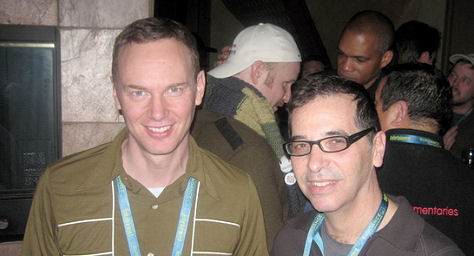
Wash Westmoreland, Richard Glatzer, who co-directed and co-wrote Qinceanera, during the ’06 Sundance Film Festival. (Pic stolen from Indiewire site.)
There was another double winner last night when Christopher Quinn’s God Grew Tired of Us won both the Grand Jury Documentary Prize as well as the Audience Doc Award — another festival first.
The World Cinema Jury Prize for Best Documentary went to Juan Carlos Rulfo’s In The Pit, which Variety‘s Robert Koehler went on about and told me to see. It explores the day-to-day lives of guys building an upper deck to Mexico City’s Periferico freeway.
The World Cinema Dramatic Jury Prize went to Gela Babluani’s 13 Tzameti. The World Cinema Audience Documentary Award was given to Tim Dirdamal’s De Nadie, about a female Central American immigrant making her way from souterhn Mexico into the U.S. And the World Cinema Audience Dramatic Award was given to Toa Fraser’s No. 2.
Here’s the official announcement.
Over and Done
The Sundance ’06 awards ceremony happens tomorrow night, and I think we all know what to expect. The jury prizes will most likely reflect elitist attitudes and determinations and be promptly ignored, and the audience awards will mean a lot more to most of those who’ve trudged through this festival over the last seven or eight days.
I’m gone tomorrow so today (Friday, 12.7) is all about last licks — catching not- yet-seen films like Wristcutters: A Love Story, which I’ll probably end up half-liking, Raymond De Felitta’s ‘Tis Autumn: The Search for Jackie Paris, The Ground Truth, In The Pit, and Half Nelson.
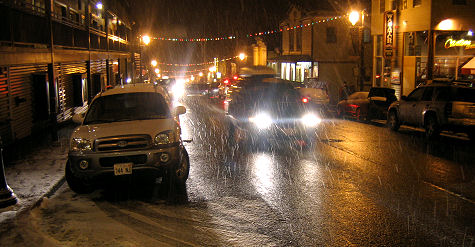
Just north of the Treasure Mountain Inn on Park City’s Main Street — Thursday, 1.26, 11:10 pm.
Several good films were shown here, but only about six or seven are are likely to make much of a dent in the real world. If a Sundance film generates a 9.5 Richter reading among festival audiences, you can usually count on half that level of juice coming from sea-level engagements…unless it’s something seriously breakout in the Napoleon Dynamite or Little Miss Sunshine mode.
Most of the industry contingent had fled Park City by late Wednesday, which was kind of welcome. It’s been easier to get into films since then and the traffic congestion around town hasn’t been nearly as bad as it was last weekend. With these and other downshiftings the fest suddenly felt like it used to in the early to mid ’90s, when it seemed more a pure-movie thing and the Paris Hilton virus had yet to manifest.
If you want a smart, no-nonsense rectitation of some of the lessons of Sundance ’06, check out this piece by Hollywood Reporter columnist Anne Thompson. I’m feeling way too whipped to assemble one of these.
A beautiful dense mountain snowfall came down last night. Watching hundreds of thousands of moisture particles floating down from the black Utah sky and the sensation of faintly sprinkled dampness upon my face made it all seem worth it. It’s just hitting me that I may have experienced as many atmospheric epiphanies during this festival as cinematic ones.
Anyway, it’s back to Los Angeles tomorrow and a five or six days of calm (I’m kidding…the Oscar nominations will be announced Tuesday) before starting in with the Santa Barbara Film Festival, which kicks off on Thursday, February 2nd.
Grabs
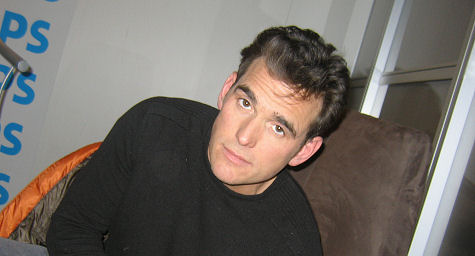
Factotum star Matt Dillon — Tuesday, 1.24, 3:40 pm. Here’s an interview I did with Dillon and Factotum director-writer Brent Hamer a couple of days ago. I didn’t like it at first because of excessive ambient noise, but I listened again this morning and some of the sentences are discernible. I couldn’t find an official Factotum site but here’s a French one
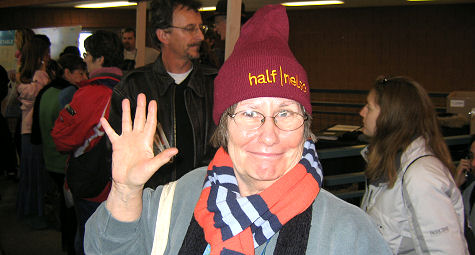
Houston-based film fan who comes here every year (and also attends the Telluride Film Festival in September) — Thursday, 1.26, 11:45 am.

It’s snowing very heavily right now, but the flakes are so small that somehow the camera can’t “see” them, even though they’re plain as day to the naked eye — Friday, 1.27, 12:50 pm.

Volunteers working the door of Holiday Village cinemas prior to screening of God Grew Tired of Us — Tuesday, 1.24, 4:10 pm.
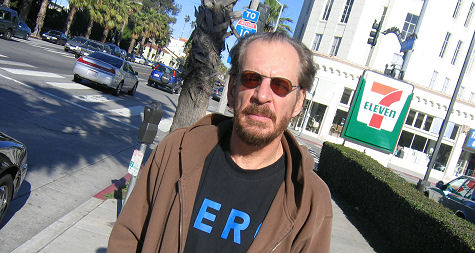
Whassup Rockers director Larry Clark in Santa Monica a few days before the start of the Sundance Film Festival. For those who didn’t hear the interview I ran with Clark a while back, here it is again.
Alarm-Sounder
Americans are so stoned and spoiled by their Treo 650s and SUV’s and McMan- sions and all the other junkie trappings of Bush-era affluence that they make the aesthetic of Marie Antoinette look like that of St. Francis of Assisi.
They’re so drunk on their lifestyles that they’re willing to kill the planet in order to keep groovin’ on. I wish it were otherwise but I really believe this, and so does George Carlin. That’s why the planet is probably doomed. That’s why…
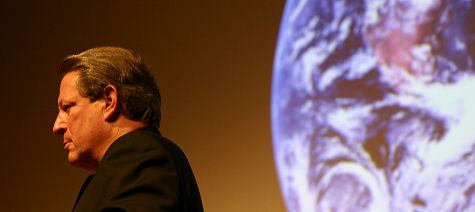
Al Gore delivering his informative global-warming lecture, which is orchestrated by director Davis Guggenhiem into a gripping, opened-up form in An Inconvenient Truth
I’m sorry. I’m stopping this now. Leftie despair can be as much of a drag as obesity and mental insulation and believing in the Church of Bush, Cheney and Big Oil.
This is a weird way of starting a piece that basically says Al Gore and his new film, An Inconvenient Truth, have given me hope and that everyone should see it. It’s strike-a-match time, and this film is a ray of light. It’s just good straight infor- mation, but if a sizable number of the “drunks” in this country see it…
I’m starting to think that Gore’s entire political career, which culiminated with his run for the White House in 2000, has been about getting people to see and fully consider this slide-show lecture movie about global warming.
An Inconvenient Truth is Gore’s crowning achievement…the summation of his life…the reason he was put on this earth to become a politican and a stirrer-upper and influencer of public opinion.
Because if people see Truth in sufficient numbers, Gore will have done more to save this planet from ruination than anyone in his realm has ever managed.

Al Gore, Robert Redford at some Sundance-type gathering that may have occured before the ’06 festival began
That’s if enough people see it and really take it in…
I saw Davis Guggenheim’s film at a press showing Wednesday afternoon and I can’t get it out of my head. It may not be the most exciting or artful or sensually swoony film of Sundance ’06, but it’s easily the most important.
It hasn’t been acquired but in a perfect synergistic world it ought to be released in April to coincide with the release of Gore’s book of “An Incovenient Truth” (Rodale), which will come out in print and audio form.
An Inconvenient Truth is as enlightening and eye-opening as a “spinach documen- tary” — i.e., very good for you and nutritious — can possibly be.
It’s just a visual opening-up of Gore’s slide show, which the former Presidential candidate and vice-president has been presenting to audiences around the globe for the last I-don’t-know-how-many years. (Gore says in the film that he’s done it about 1,000 times.)
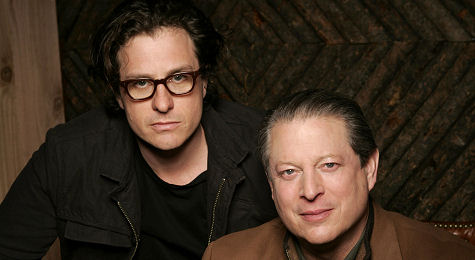
Davis Guggenheim and Al Gore
Gore’s teaching style is folksy, straight and very personable. (It’s too bad he wasn’t half this charming or persuasive during the 2000 Presidential election.) Go to this Gore-sponsored website to research the facts, but set aside the time to go see it when it hits a nearby theatre or DVD store.
Seriously — no other film I’ve seen has spelled out the problem quite so clearly. Everyone on the planet needs to see it…even if they think they know everything there is to know about the harm being done to this planet. And it’s bad…really bad.
But there’s a road beyond the despair that I started this piece with, and Gore’s film is an attempt to show the way.
One more thought, and I’m not just saying this to be a smart-ass: this film is very persuasive, but it would be a tad more so if Gore were a little bit thinner. He’s not Oliver Hardy but he looks very well fed, and the metaphor is obvious. The under- message of An Inconvenient Truth suggests that a new kind of austerity is vital for the earth’s survival, and I feel it would play better if Gore looked like someone who practices more denial.
Dick’s MPAA Flap
Kirby Dick is complaining that the MPAA illegally copied, apparently for internal purposes, a “digital version” of his new film This Film Is Not Yet Rated, which a several journos saw at a press screening yesterday morning and which screens at 9:30 pm tonight at the Sundance Film Festival.
More to the point, Dick got L.A. Times reporter John Horn to do the squawking for him in a piece that ran Wednesday (1.25) called “Avast, Ye Pirates!” It struck me as a thin beef, but it made for good press.
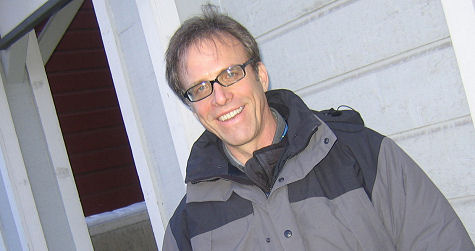
This Film Is Not Yet Rated director Kirby Dick on Park City’s Main Street — Tuesday, 1.24, 4:20 pm.
The dust-up was partly about an issue of secrecy, but what it really boiled down to was one of anger and frustration on the part of Dick and many, many film directors who have long despised what they see as an unfair and highly arbitrary ratings system.
And so Dick has struck back at the MPAA in a nyah-nyah way that he knows will hurt and enrage the ratings and appeals board members — he’s “outed” them.
The MPAA has a policy of keeping the identities of the its Ratings and Classification Board secret. Dick’s position is that filmmakers have the right to know the names of those people on the MPAA ratings board who occasionally slap their films with absurd and restrictive ratings that end up hurting the economic prospects of their films.
Therefore, This Film Is Not Yet Rated is partly about Dick hiring a lesbian private investigator to unmask the identities of the MPAA’s ratings board members, as well the big wheels on the appeals board.
The film tracks the progess of Dick and his investigator (along with the woman’s junior assistant) as they park outside MPAA headquarters in the L.A. suburb of Woodland Hills, write down their license plate numbers, follow them on their way to restaurants and on errands, and in one case sifting through garbage.
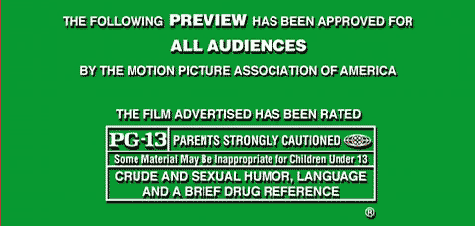
By the end of the film the raters are pretty much totally exposed — names, backgrounds, in some cases photos, the ages of their children, and in some instances the kind of cars they drive.
Horn’s story says that Michael Donaldson, a lawyer representing Dick, has written the MPAA and demanded that it “immediately return all copies” of the film in its possession and explain who approved the making of the copy and who within the MPAA has looked at the reproduction.”
Dick recently discovered during a recent conversation with an MPAA lawyer that the MPAA had copied the film from a digital version he submitted on 11.29 for a rating. The MPAA’s copy of Dick’s film was viewed by Dan Glickman, the MPAA’s new president, the MPAA said.
“Dick said that when he asked MPAA lawyer Greg Goeckner what right his organization had to make the copy, Goeckner told him that Dick and his crew had potentially invaded the privacy of the MPAA’s movie raters,” Horn’s story says.
“We made a copy of Kirby’s movie because it had implications for our employees,” said Kori Bernards, the MPAA’s corporate communications vp. She told Horn that Dick’s spying on the MPAA raters led the organization to feel “concerned about the raters and their families,” Bernards said.
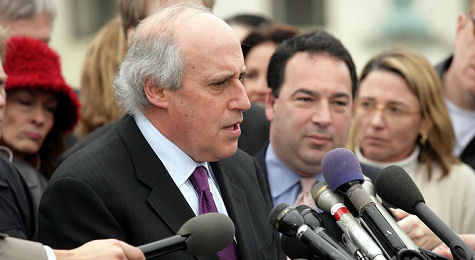
MPAA chief Dan Glickman
She said the MPAA’s copy of This Film Is Not Yet Rated is “locked away” and is not being copied or distributed.” She added that the organization was operating lawfully when it copied Dick’s movie, saying that “the courts recognize that parties are entitled to make a copy of a work for use as evidence in possible future proceedings.”
MPAA chief Dan Glickman told AP reporter Dave Germain that normally he doesn’t watch films submitted for ratings but that he viewed most of This Film Is Not Yet Rated — the MPAA’s copied version, apparently — because he “heard they used unusual surveillance techniques to follow our raters around.”
“I decided the privacy of our employees was in jeopardy. I didn’t know if there was some violation of law, maybe, but I thought that was going way too far,” Glickman said.
Dick’s film is a hugely entertaining, sharp-tongued trashing of the MPAA’s absurd and politically lopsided rating calls.
These include the board’s well-known tendency to attach R and NC-17 ratings to films showing scenes of sexual pleasure but allow scenes showing horrific and/or grotesque violence to prretty much skate. The ratrings board is also known for being harder on depictions of gay over hetero sex, and for giving indies a harder time than the majors.
The sage and sometimes very funny talking heads include directors John Waters, Kevin Smith, Todd Solondz, Wayne Kramer, and indie distributors Mark Urman and Bingham Ray.
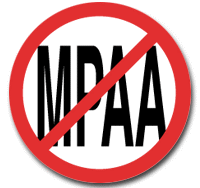
Grabs
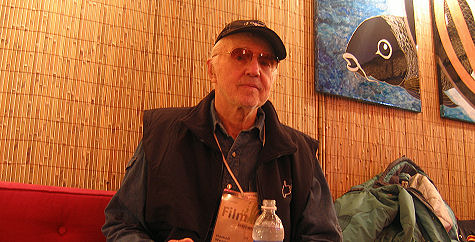
Haskell Wexler, director of Who Needs Sleep?, at the VW Lounge on upper Main Street — Tuesday, 1.24, 3:45 pm.
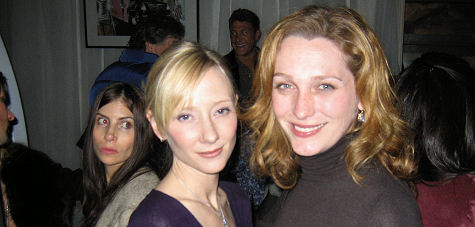
Anne Heche and a friend/colleague at the after-party for Wim Wenders’ Don’t Come Knocking — Tuesday, 1.14, 11:50 pm. I searched through Heche’s IMDB profile and don’t see a Sundance ’06 film among her credits, so I guess…well, it was nice to say hello.
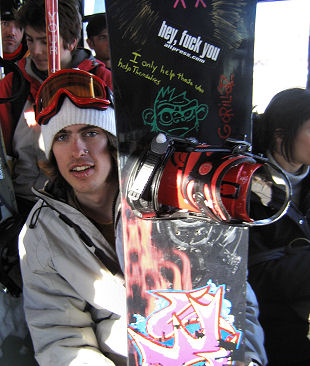
Non-celebrity on bus heading into town from Kimball Junction
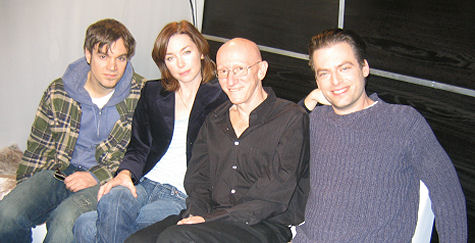
Flannel Pajamas costars Jamie Harrold (I think) and Julianne Nicholson, the film’s director-screenwriter Jeff Lipsky, and costar Justin Kirk — Tuesday, 1.24, 2:19 pm. Roger Ebert has praised this unusual romantic drama, and a woman I spoke to an hour ago has said, ‘Naaah…not for me.” That makes it an absolute must-see.
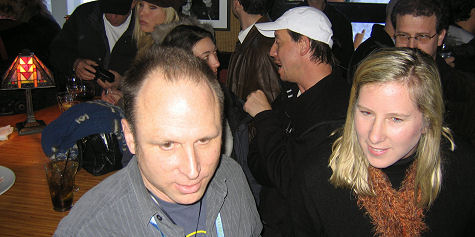
Picturehouse chief Bob Berney (lower left) during latter stages of party thrown by his company at Zoom on lower Main Street — Tuesday, 1.24, 5:15 pm .

Ashley Judd, star of Joey Lauren Adams’ Come Early Morning, presenting a Women in Film award to Adams — Monday, 1.24, 8:10 pm.

Exterior of Riverhorse Cafe — Tuesday, 1.24, 4:10 pm.

Dining room of Park City’s Riverhorse Cafe during Women in Film party — Monday, 1.23, 7:25 pm.

Documentarian and Entourage costar Adrian Grenier on Main Street outside VW lounge — Tuesday, 1.24, 3:55 pm.
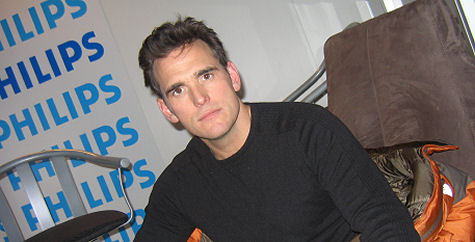
Matt Dillon during our interview about Brent Hamer’s Factotum, the latest and finest Charles Buklowski-inspired film ever made. Dillon’s performance as Bukowski’s alter-ego Henry Chinaski isn’t just more nuanced and naturalistic than Mickey Rourke’s riff on the boozy writer-poet in Barfly and Ben Gazarra’s in Tales of Ordinary Madness — it also exudes an exceptional dignity.

Hanging in one of Park City’s two townie bars.
